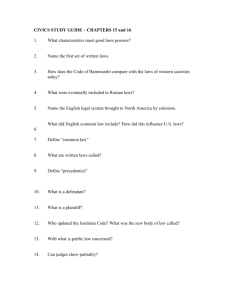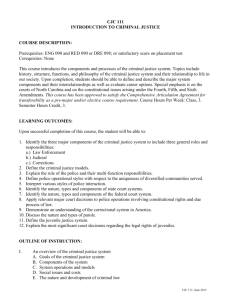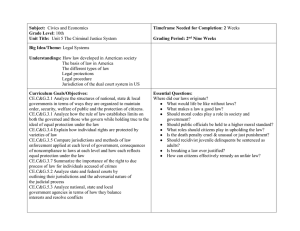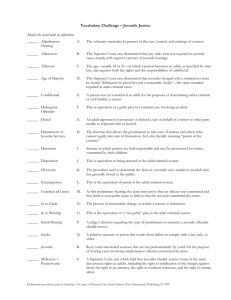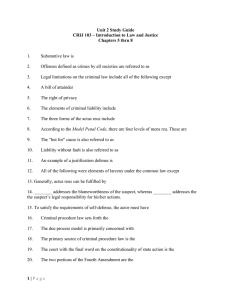criminal law and juvenile law
advertisement
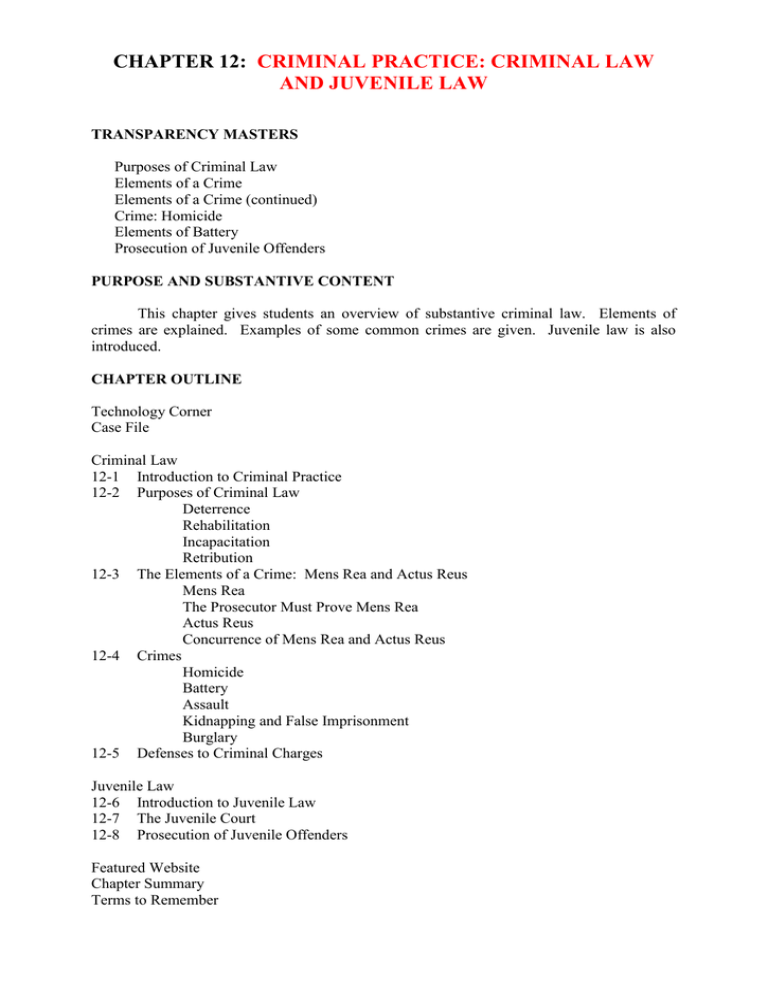
CHAPTER 12: CRIMINAL PRACTICE: CRIMINAL LAW AND JUVENILE LAW TRANSPARENCY MASTERS Purposes of Criminal Law Elements of a Crime Elements of a Crime (continued) Crime: Homicide Elements of Battery Prosecution of Juvenile Offenders PURPOSE AND SUBSTANTIVE CONTENT This chapter gives students an overview of substantive criminal law. Elements of crimes are explained. Examples of some common crimes are given. Juvenile law is also introduced. CHAPTER OUTLINE Technology Corner Case File Criminal Law 12-1 Introduction to Criminal Practice 12-2 Purposes of Criminal Law Deterrence Rehabilitation Incapacitation Retribution 12-3 The Elements of a Crime: Mens Rea and Actus Reus Mens Rea The Prosecutor Must Prove Mens Rea Actus Reus Concurrence of Mens Rea and Actus Reus 12-4 Crimes Homicide Battery Assault Kidnapping and False Imprisonment Burglary 12-5 Defenses to Criminal Charges Juvenile Law 12-6 Introduction to Juvenile Law 12-7 The Juvenile Court 12-8 Prosecution of Juvenile Offenders Featured Website Chapter Summary Terms to Remember Questions for Review Questions for Analysis Assignments and Projects SKILL BUILDING The examples, assignments, case questions, and projects provide the opportunity for students to build the following skills: Critical Thinking Legal Analysis Writing Working in Groups Computer CASE SUMMARIES, CASE QUESTIONS,AND SUGGESTED ANSWERS United States v. Falkowski, 900 F. Supp 1207 (D.Alaska 1995) (Pg. 260) In this criminal case, defendant Falkowski was indicted on charges related to the cultivation and distribution of marijuana. The day following the criminal indictment, the government filed civil forfeiture proceedings against real property obviously used in the commission of the crime. The sequence of the events following is important. On October 14, defendant was arrested. On November 5, the United States sought entry of default in the civil forfeiture case. On November 13, defendant pled guilty to some of the criminal charges pursuant to a plea agreement. On December 2, the government made a second request to enter default in the civil forfeiture action. On December 14, the clerk entered default in the civil forfeiture proceeding. On February 2, the United States moved for a decree of forfeiture. On July 28, defendant was sentenced in the criminal case. Defendant appealed the criminal conviction claiming that the civil forfeiture and criminal sentence constituted double jeopardy and because the sentence was the last to be imposed, the conviction must be set aside. The court stated that there were three reasons why the attack on the criminal case must fail. First, jeopardy attached in the criminal case before the default judgment was entered in the civil proceeding. Second, by entering a plea of guilty, defendant waived or forfeited the right to collaterally attack his conviction and sentence on double jeopardy. Third, the civil forfeiture was not based upon the same offense for which defendant was criminally prosecuted. 1. Summarize the facts that lead up to the defendant’s claim that he had been subjected to double jeopardy. Suggested Answer: On October 6, 1992, Falkowski and co-defendants were indicted on charges related to the cultivation and distribution of marijuana. The indictment contained criminal forfeiture counts addressing property in which Falkowski was alleged to claim an interest. On October 7, 1992, the day following the return of the indictment, the government filed civil forfeiture proceedings against real property located at 1804 Caribou Way in Fairbanks, Alaska. This property was also listed in the indictment. On October 14, 1992, Falkowski was arrested and simultaneously served with notice of the arrest of the property at 1804 Caribou Way. On November 5, 1992, the United States sought entry of default against Falkowski in the civil forfeiture case. On November 13, 1992, Falkowski pled guilty to some of the charges in the indictment pursuant to a plea agreement anticipating that the other counts would be dismissed. The charges to which Falkowski pled included conducting a continuing criminal enterprise, money laundering, and investing drug proceeds in a business enterprise. As part of the plea agreement, Falkowski agreed to forfeit any property 1) that he acquired as a result of drug trafficking and 2) to assist the government in locating and seizing any such property. The plea agreement did not specify whether the property at 1804 Caribou Way would be forfeited civilly or criminally. In fact, the plea agreement made no specific reference to the Caribou Way property or the civil forfeiture proceeding. On December 2, 1992, the government made a second request to enter default against Falkowski in the civil forfeiture action. On December 14, 1992, the clerk entered a default against all defendants or claimants in the forfeiture action who had not filed claims, answer, or responses. The defaulted parties included Falkowski. On February 2, 1993, the United States moved for a decree of forfeiture, relying in part on the declaration and order of default. The 1804 Caribou Way property was ordered forfeited to the United States by an order entered on February 10, 1993. On July 28, 1993, the district court sentenced Falkowski to identical concurrent seventy-two month sentences on each of the counts of conviction. 2. What were the legal questions before the court? Suggested Answer: The main issue in this case was whether the civil forfeiture and criminal sentence constituted double jeopardy. In deciding this issue, the court also had to determine if the elements of the civil forfeiture were the same as the elements of the criminal offense. 3. Based on what you read in this case, what is civil forfeiture? Suggested Answer: Civil forfeiture is the government’s claiming of property that is acquired as a result of a criminal action or is used in the commission of a criminal offense. Roy v. Gomez, 55 F. 3d 1483 (9th Cir. 1995) (Pg. 266) This criminal case deals primarily with the felony-murder rule. Defendant Roy and a friend, McHargue, were charged with two counts of robbery and two counts of first degree murder. The facts leading to the charges are as follows. The two victims picked up both defendants, who were hitchhiking. The prosecutor argued that the defendants planned to drive to a remote location, rob and kill both victims, and steal their pickup truck. When defendants were arrested, a search of Roy produced a knife, cash, and a watch later identified as belonging to victim Mannix. Roy also made statements to fellow inmates in jail and these statements were admitted into evidence at trial. The facts indicated that Roy killed victim Clark while defendant McHargue was struggling with defendant Mannix, and that after Roy killed Clark, Roy helped McHargue rob and kill Mannix. The jury found Roy guilty of second-degree murder for killing Clark, but found him not guilty of robbing Clark. They found him guilty of first-degree murder in the killing of Mannix. Roy appealed stating that the finding of second degree murder in the Clark killing eliminated the theory of premeditation. The only way that the first-degree murder could stand would be under the theory of the felony murder rule. In connection with this, defendant claims that the court committed a Beeman error in the instructions, in that the court failed to tell the jury that an aider or abettor must not only know the unlawful purpose of the accomplice but must intend to encourage or facilitate the commission of the offense—in this case a robbery. The California Court of Appeal affirmed the felony murder verdict stating that the Beeman error was harmless. The federal court agreed. The court felt that no jury could fail to find that Roy intended to aid McHargue in robbing Mannix. 1. Summarize the facts of the Gomez case. Suggested Answer: Defendant Roy and a friend, McHargue, were charged with two counts of robbery and two counts of first degree murder. The facts leading to the charges are as follows. The two victims picked up both defendants, who were hitchhiking. The prosecutor argued that the defendants planned to drive to a remote location, rob and kill both victims, and steal their pickup truck. When defendants were arrested, a search of Roy produced a knife, cash, and a watch later identified as belonging to victim Mannix. Roy also made statements to fellow inmates in jail and these statements were admitted into evidence at trial. The facts indicated that Roy killed victim Clark while defendant McHargue was struggling with defendant Mannix, and that after Roy killed Clark, Roy helped McHargue rob and kill Mannix. The jury found Roy guilty of seconddegree murder for killing Clark, but found him not guilty of robbing Clark. 2. What is the legal issue in Gomez? Suggested Answer: The legal issue is whether the trial court’s failure to properly instruct on the law regarding felony-murder (specifically that an aider or abettor must intend to facilitate the commission of the felony) entitles defendant to a reversal on appeal. 3. Why did the court affirm the lower court’s ruling? Suggested Answer: The court felt that any error committed by the trial court was harmless. The court found that implied in the jury’s finding on other issues was the fact that Roy intended to encourage or facilitate the commission of the robbery. Schweinle v. Texas, 915 S.W.2d 17 (Tex. Crim. App. 1996) (Pg. 269) In this criminal case, defendant was found guilty of aggravated kidnapping. The crime arose out of a situation involving a domestic dispute. After a fight, defendant “abducted” his girl friend, beat her, and took her to his house where he kept her over night. Under Texas law, the offense of kidnapping occurs if a defendant intentionally or knowingly abducts another. Abducts means to secrete or hold a person in a place where he is not likely to be found or using or threatening to use deadly force. Also under Texas law, the offense of false imprisonment is committed if a defendant knowingly restrains another person. At trial, the jury was instructed as to the crime of kidnapping but not as to the crime of false imprisonment. Defendant appealed claiming that the jury should have been instructed as to false imprisonment because it is a lesser-included offense of kidnapping and the facts in this case supported such a finding. The Court of Appeal affirmed the trial court finding but the Texas high court granted discretionary review. It found that false imprisonment was a lesserincluded offense of kidnapping. The second issue required more discussion, but the Court stated that a jury could have found that no deadly force was used or threatened. The defendant testified that he did not touch the gun nor point it at the victim. Furthermore, he testified that he always carried the gun in his truck and the victim knew this. Also, the Court said that a jury could have found that in view of the fact of the relationship between the parties, his house might not have been a place where she was not likely to be found. The Court reversed and remanded. 1. Why did the court remand the case to the court of appeals? Suggested Answer: The court of appeals found that it was not necessary to instruct on the lesser-included offense of false imprisonment. The high court disagreed. The case was remanded to the court of appeal so that it could analyze whether the failure to instruct on the lesserincluded offense was a harmless error or not. 2. According to what you read in Schweinle, what is a lesser included offense? Suggested Answer: An offense is a lesser-included offense if it is established by proof of the same, or less, facts that are required to prove the offense charged. 3. Under the Model Penal Code, did the appellant commit the crime of kidnapping? Explain using the appropriate elements of the Model Penal Code set forth in the text. Suggested Answer: The Model Penal Code provides that kidnapping is the unlawful taking, confinement, and carrying away of another person, by threat, force, fraud, or deception. In this case, it seems obvious that the defendant did commit the crime of kidnapping as defined in the Model Penal Code. The defendant unlawfully took, transported, and confined another. The Model Penal Code says nothing about keeping the victim in a place where she is not likely to be found. Furthermore, defendant in this case threatened and forced the victim to come with him. He dragged her and slapped her. Unlike the Texas law, the Model Penal Code does not require deadly force, only threats or nondeadly force. In Re Gault, 387 U.S. 1 (1967) (Pg. 274) In the Gault case, police arrested a juvenile for making obscene phone calls. After denying him substantial due process rights, Gault, age 15, was committed to an institution until he should reach his majority. The U.S. Supreme Court held that juveniles are entitled to several due process rights under the U.S. Constitution. Specifically, the juvenile and his parents are entitled to adequate written notice of the specific issues in the case. This notice must be given sufficiently in advance of the hearing to permit preparation. The child and his parents must be advised of their right to counsel and if unable to afford counsel, that one will be appointed. The constitutional privilege against self-incrimination is applicable. A juvenile must be afforded the right of confrontations and sworn testimony of witnesses available for cross-examination. 1. What constitutional right was Gault denied during the adjudicatory stage of the juvenile process? Suggested Answer: Gault was denied the constitutional right of due process. 2. What does due process require in the adjudicatory stage of the juvenile process? Suggested Answer: Specifically, the juvenile and his parents are entitled to adequate written notice of the specific issues in the case. This notice must be given sufficiently in advance of the hearing to permit preparation. The child and his parents must be advised of their right to counsel and if unable to afford counsel, that one will be appointed. The constitutional privilege against self-incrimination is applicable. A juvenile must be afforded the right of confrontations and sworn testimony of witnesses available for cross-examination. 3. Does a juvenile have a right against self-incrimination? Discuss. Suggested Answer: This Court makes it clear that a juvenile does have a right against self-incrimination. Furthermore, this Court points out that admissions and confessions by juveniles require special caution as to their reliability and voluntariness. Special problems may also arise when a juvenile attempts to waive these rights. Breed v. Jones, 421 U.S. 519 (1975) (Pg. 275) In this case, a petition was filed in the Juvenile Division of the Superior Court seeking to have the juvenile declared a ward of the court on the ground that he committed an act (armed robbery) which would be a crime had he been an adult. At an adjudicatory hearing, the facts of the petition were found to be true. At that point, the juvenile court also found that the juvenile was not fit for juvenile proceedings and transferred the case to the Superior Court for him to be tried as an adult. The juvenile claimed that this was double jeopardy. Eventually the case reached the U.S. Supreme Court, which held that even if there were no double punishment, double jeopardy applied because he was required to go through two trials for basically the same offense. 1. What is the legal issue in the Breed case? Suggested Answer: The legal issue is whether double jeopardy applies once a juvenile has been through an adjudicatory hearing in which he is found to have committed acts that would be a crime were he an adult. In other words, can a juvenile be tried as an adult after an adjudicatory hearing by a juvenile court? 2. Explain why the Court found that the double jeopardy clause of the Fifth Amendment was violated by the California courts. Suggested Answer: The respondent in this case was subjected to the burden of two trials for the same offense; he was twice put to the task of marshaling his resources against those of the State, twice subjected to the heavy personal strain that such an experience represents. The Supreme Court stated that this type of prosecution posed potential consequences of additional stigma inherent in the criminal determination and the possibility of the deprivation of liberty for many years. ETHICAL CHOICES You are a case assistant. You sit in on an interview with a criminal defendant who admits to your supervising attorney that he did in fact commit the crime in question. At trial, the client takes the stand and testifies that he had nothing to do with the crime. Should you do anything about either the client or the attorney? (Pg. 272) Points to Discuss: How far does preserving a client’s confidence extend? If you know your client has lied in court is there any obligation? Must you always maintain a client confidence in criminal cases? Are there any exceptions? What if someone could be injured? What if a client threatens to commit another crime? QUESTIONS FOR ANALYSIS 1. Locate the juvenile court rules for your jurisdiction. Choose two statutes. Rewrite them, breaking them into their elements. Review the statutes for assault, battery, and kidnapping in this chapter to review how a statute is broken apart into elements. Answers will vary from state to state 2. Reread the Case File at the beginning of the chapter. What crimes has the client committed? Explain your answer by discussing the facts and the elements of the crimes. Suggested Answer: Assault and Battery –Throwing the bottle of beer at the victim and actually hitting him with it constitutes an assault and battery—causing apprehension and intentional and harmful touching. None of the previous conduct is criminal. Shoving a hand away after being poked is probably reasonable force in response to the initial “poking.” The statement to stay away from him or “you’ll be sorry” is not a sufficient threat to constitute an assault. Should the victim die, manslaughter or negligent homicide would probably result. Chapter 12: Criminal Practice: Criminal Law and Juvenile Law True/False 1. The Model Penal Code has been adopted in all states. 2. A rebuttable presumption means that the presumption may be disproved by the facts. 3. Most crimes have two basic elements. 4. Crimes can be committed against the public. 5. Crimes are generally categorized into felonies, misdemeanors, and petty offenses. 6. Homicide is the taking of the life of one person by another. 7. A battery is the reckless or intentional injuring of a person. 8. There is general uniformity among the states in how the juvenile court system works. 9. In simplistic terms, juveniles are delinquent when they commit a violation of the law. 10. Paralegals may review physical evidence. Multiple Choice 1. Which of the following is not a purpose of criminal law? a. b. c. d. e. deterrence retribution incapacitation rehabilitation mens rea 2. Which of the following is an element of mens rea? a. b. c. d. a knowing act a purposeful act a reckless act a and c e. all of the above 3. Crimes can be committed against: a. b. c. d. e. property persons the public b and c all of the above 4. Which of the following is not a defense to a criminal charge? a. b. c. d. e. duress self-defense diminished capacity mistake all of the above 5. Paralegals may not: a. b. c. d. e. hire investigators set fees give legal advice appear in court on behalf of a client all of the above 6. Paralegals may: a. b. c. d. e. and c prepare trial notebooks assist at trial interview witnesses negotiate with a prosecutor a, b, 7. The Model Penal Code is: a. b. c. d. e. a set of uniform laws for all federal criminal cases a collection of criminal statutes a uniform collection of criminal laws followed by all states a uniform collection of criminal laws followed by the federal courts a and b 8. Actus reus is: a. b. c. d. e. an element of mens rea another term for a purposeful act the second element of a crime the intent element of mens rea b and c 9. A felony is often punishable by: a. b. c. d. e. a minimum one year’s imprisonment a minimum of six months’ imprisonment time off for good behavior a and b none of the above 10. First degree murder is a homicide that is: a. b. c. d. e. premeditated willful deliberate a and c a, b, and c Answer Key 1. False 7. False 2. True 8. False 3. True 9. True 4. True 10. True 5. True 6. True 1.e 7.b 2.e 8.c 3.e 9.a 4.d 10.e 5.e 6.e


